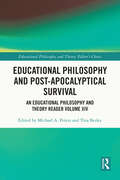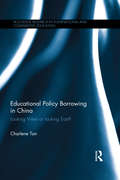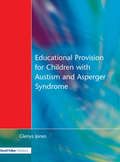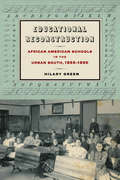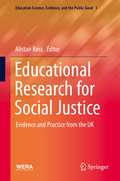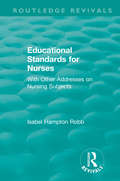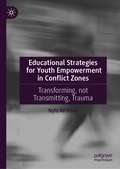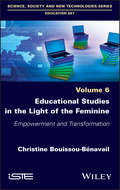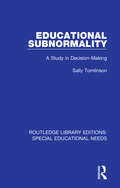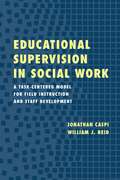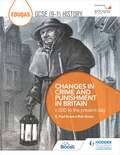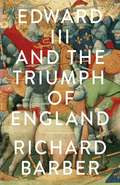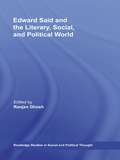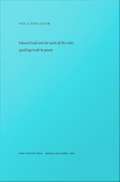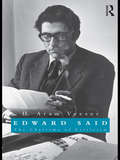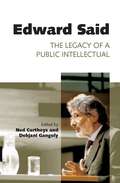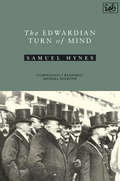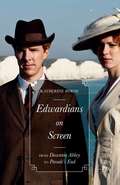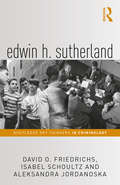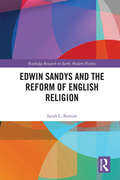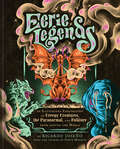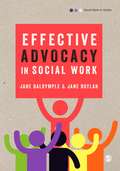- Table View
- List View
Educational Philosophy and Post-Apocalyptical Survival: An Educational Philosophy and Theory Reader Volume XIV (Educational Philosophy and Theory: Editor’s Choice)
by Michael A. Peters Tina BesleyThis collection concerns educational philosophy and post-apocalyptical survival. This 14th volume in the Editor's Choice series provides insights into the philosophy of education as it relates to the concepts of civilizational collapse, discourses of decline, educating for survival amid climate emergency, cultural apocalypse and the pandemic. It is based on a series of editorials and articles published in the Educational Philosophy and Theory journal through its 55-year history. The articles, written by Editor Michael Peters and colleagues, explore the concept of global apocalypse from the educational philosophy lens. It will be of interest to scholars in philosophy of education and anyone who is working in the field of post-apocalyptic studies.
Educational Policy Borrowing in China: Looking West or looking East? (Routledge Research in International and Comparative Education)
by Charlene TanFor over a decade, Mainland China has been embarking on an ambitious nation-wide education reform ('New Curriculum Reform') for its basic education. The reform reflects China’s propensity to borrow selected educational policies from elsewhere, particularly North America and Europe. Chinese scholars have used a local proverb "the West wind has overpowered the East wind" to describe this phenomenon of ‘looking West’.But what do we mean by educational policy borrowing from the West? What are the educational policies in China's new curriculum reform that are perceived to be borrowed from the West? To what extent have the borrowed educational policies in China's new curriculum reform been accepted, modified, and rejected by the various educational stakeholders? How does culture influence the various educational stakeholders in China in interpreting and mediating educational policy borrowing from the West? How do the findings of this study on China’s education reform inform and add to the existing theories on and approaches to on cross-cultural educational policy borrowing? This book answers the above questions by critically discussing China’s policy borrowing from the West through its current reform for primary and secondary education. It presents the latest in-depth research findings from a three-year empirical study (2013-2015) with school principals, teachers, students and other educational stakeholders across China. This study offers new insights into China’s educational policy borrowing from the West and international implications on cross-cultural educational transfer for academics, policymakers and educators.
Educational Provision for Children with Autism and Asperger Syndrome: Meeting Their Needs
by Glenys JonesThe range of educational options available to a child with Autism and Asperger syndrome is broad, but choosing the right path can often be a complex task for all involved. This book provides information and advice for professionals and parents making crucial decisions about meeting the needs of children with autistic spectrum disorder. It covers the range of intellectual ability from those having severe learning difficulties to those of above average intelligence. Practical advice for those working with children from preschool to post-16 is given on: choosing the most appropriate educational placement; making decisions on which educational interventions to follow; creating an effective educational environment; working with staff and other children to maximum effect; writing effective individual education plans; working with parents and families; enabling a smooth transition between classes and stages of education; and life beyond school.
Educational Reconstruction: African American Schools in the Urban South, 1865-1890 (Reconstructing America)
by Hilary N. GreenTracing the first two decades of state-funded African American schools, Educational Reconstruction addresses the ways in which black Richmonders, black Mobilians, and their white allies created, developed, and sustained a system of African American schools following the Civil War.Hilary Green proposes a new chronology in understanding postwar African American education, examining how urban African Americans demanded quality public schools from their new city and state partners. Revealing the significant gains made after the departure of the Freedmen’s Bureau, this study reevaluates African American higher education in terms of developing a cadre of public school educator-activists and highlights the centrality of urban African American protest in shaping educational decisions and policies in their respective cities and states.
Educational Research for Social Justice: Evidence and Practice from the UK (Education Science, Evidence, and the Public Good #1)
by Alistair RossThis book presents a series of analyses of educational policies – largely in the UK, but some also in Europe – researched by a team of social scientists who share a commitment to social justice and equity in education. We explore what social justice means, in educational policy and practice, and how it impacts on our understanding of both ‘educational science’ and ‘the public good’. Using a social constructivist approach, the book argues that social justice requires a particular and critical analysis of the meaning of meritocracy, and of the way this term turns educational policies towards treating learning as a competition, in which many young people are constructed as ‘losers’. We discuss how many terms in education are essentialised and have specific, and different, meanings for particular social groups, and how this may create issues in both quantitative survey methods and in determining what is ‘the public good’. We discuss social justice across a range of intersecting social characteristics, including social class, ethnicity and gender, as they are applied across the educational policy spectrum, from early years to postgraduate education. We examine the ways that young people construct their identities, and the implications of this for understanding the ‘public good’ in educational practice. We consider the responsibilities of educational researchers to acknowledge these issues, and offer examples of researching with such a commitment. We conclude by considering how educational policy might contribute to a socially just, equitable and inclusive public good.
Educational Standards for Nurses: With Other Addresses on Nursing Subjects (Routledge Revivals)
by Isabel Hampton RobbOriginally published in 1907, this title was one of several influential textbooks on nursing written by Isabel Hampton Robb, a nursing theorist. The first superintendent of nurses at Johns Hopkins School of Nursing she helped to found key organizations for nurses in the USA. Her work in nursing has led to her being thought of as a founder of modern American nursing theory, and many of the standards she implemented are still in place today. Hampton also played a large role in advancing the social status of nursing, previously thought of a profession for the lower classes. Her work in developing a curriculum of more advanced training during her time at the Johns Hopkins School of Nursing raised the status of the profession. Nursing education today would not be what it is without the contribution of Isabel Hampton Robb.
Educational Strategies for Youth Empowerment in Conflict Zones: Transforming, not Transmitting, Trauma
by Nyla Ali KhanThis book offers fresh and exciting new directions of inquiry into the highly contentious issue of conflict resolution in South Asia. By shifting its gaze from a politics of division mired in ethno-nationalisms into a healing and restorative focus, the author moves the dialogue forward into the realm of community, healing, and shared governance. The book analyzes the major constitutional and political missteps that have led to the current situation of violence and distrust in countries such as India and Pakistan, keeping the focus on Jammu and Kashmir. This monograph will appeal to a wide range of audiences including academics, researchers, graduate students interested in South Asian politics, development, trauma studies, and peace and conflict studies.
Educational Studies in the Light of the Feminine: Empowerment and Transformation
by Christine Bouissou- BenavailFrom the theory-practice couple, there are various ways to approach educational and training issues. Intervention research, reflexive situated action and innovation are some of them. Through the analysis of the author's various experiences - professional and initial training, support for change, organizational assessment, experiential learning, project management - this book explores questions about social or professional contexts and the subjective training of actors. One of the challenges is to understand and challenge phenomena such as the development of autonomy and subsidiarity in changing academic or academic contexts. The book promotes the emergence of an ethical and resilient subjectivity. It will show that storytelling is methodological resources for research-intervention paradigms, support the development of actors and stimulate mobility. The book introduces the hypothesis of an operational principle of the feminine as fluid gender, added value to the collective intelligences of the processes of transformation of education and teaching, in terms of intergenerational transmission and in terms of transferability and Strategic activation of skills between business sectors and intellectual fields. This praxeology reconsiders organizations, temporalities, frames of reference, relaunches a reflection in action at the heart of structuration-transformation projects in governance of public action, as well as in terms of personal and collective encapacitation. The reflection opens to questions of management of conflictualities and management of the subjective, epistemological and professional economies.
Educational Subnormality: A Study in Decision-Making (Routledge Library Editions: Special Educational Needs #55)
by Sally TomlinsonFirst published in 1981. Based on a three-year study of children moving into special ESN-M education in an English city in the mid-1970s, this book questions the whole concept of mild educational subnormality by examining the criteria according to which professionals make decisions to place children within this stigmatised category. It suggests that the beliefs that the professionals hold about the behavioural, family and class characteristics of the children help to determine their judgements, and that these beliefs are related to their own position within the social structure.
Educational Supervision in Social Work: A Task-Centered Model for Field Instruction and Staff Development
by Caspi Jonathan William ReidThrough its emphasis on meeting learning objectives, the Task-Centered Model for Educational Supervision (TCS) accommodates new models of field instruction in social work, teaching accountability in fieldwork supervision and instructing novice social workers in how to be self-initiating and evaluative. The application of the TCS model in various real-life education and practice environments is illustrated by detailed case vignettes throughout the book.
Educational Supervision in Social Work: A Task-Centered Model for Field Instruction and Staff Development (Critical Perspectives On Animals Ser.)
by William J. Reid Jonathan CaspiThis book provides a comprehensive examination of instructional supervision and introduces the Task-Centered Model for Educational Supervision (TCS). It begins by reviewing the history of educational supervision in social work and principles of effective teaching practices in the field. While theories about the principles and purposes of educational supervision abound, it has proven difficult to translate these ideas into a coherent model of supervisory practice. Educational Supervision in Social Work answers that need, presenting in detail TCS, an ordered series of discrete activities that supervisors and supervisees follow during and between supervision meetings. Designed to promote the continuous attainment of learning and practice objectives, TCS accommodates new models of field instruction, addresses common accountability concerns in social work supervision, and teaches practitioners how to be self-initiating and evaluative. Focusing on the practical implementation of TCS, Caspi and Reed have included detailed case vignettes throughout the book that provide concrete examples of putting theory into practice. Both supervisors of interns and staff as well as supervisees will find TCS a helpful tool in the supervisory process.
Educations in Ethnic Violence
by Matthew LangeIn Educations in Ethnic Violence, Matthew Lange explores the effects education has on ethnic violence. Lange contradicts the widely held belief that education promotes peace and tolerance. Rather, Lange finds that education commonly contributes to aggression, especially in environments with ethnic divisions, limited resources and ineffective political institutions. He describes four ways in which organized learning spurs ethnic conflicts. Socialization in school shapes students' identities and the norms governing intercommunal relations. Education can also increase students' frustration and aggression when their expectations are not met. Sometimes, the competitive atmosphere gives students an incentive to participate in violence. Finally, education provides students with superior abilities to mobilize violent ethnic movements. Lange employs a cross-national statistical analysis with case studies of Sri Lanka, Cyprus, the Palestinian territories, India, sub-Saharan Africa, Canada and Germany.
Eduqas GCSE (9-1) History Changes in Crime and Punishment in Britain c.500 to the present day
by R. Paul Evans Rob QuinnExam board: EduqasLevel: GCSESubject: HistoryFirst teaching: September 2016First exams: June 2018Endorsed by EduqasHelp every student to achieve their best, with bespoke support for Eduqas GCSE History from the leading History publisher for secondary schools.Structured around the key questions in the 2016 specification, this book:> Develops in-depth subject knowledge through clear and detailed coverage of the important themes, perspectives and developments> Builds students' historical skills and thinking as they progress through a range of activities and questions> Prepares students for assessment by providing step-by-step guidance and model answers for each question type> Increases understanding and enjoyment by including a rich variety of source material that brings different periods to life
Eduqas GCSE (9-1) History Changes in Crime and Punishment in Britain c.500 to the present day
by R. Paul Evans Rob QuinnExam board: EduqasLevel: GCSESubject: HistoryFirst teaching: September 2016First exams: June 2018Endorsed by EduqasHelp every student to achieve their best, with bespoke support for Eduqas GCSE History from the leading History publisher for secondary schools.Structured around the key questions in the 2016 specification, this book:> Develops in-depth subject knowledge through clear and detailed coverage of the important themes, perspectives and developments> Builds students' historical skills and thinking as they progress through a range of activities and questions> Prepares students for assessment by providing step-by-step guidance and model answers for each question type> Increases understanding and enjoyment by including a rich variety of source material that brings different periods to life
Edward III and the Triumph of England: The Battle of Crécy and the Company of the Garter
by Richard BarberA fascinating recreation of the world of one of England's most charismatic monarchs, from award-winning author and historian Richard BarberThe destruction of the French army at Crécy in 1346 and the subsequent siege and capture of Calais marked a new era in European history. The most powerful, glamorous and respected of all western monarchies had been completely humiliated by England, a country long viewed either as a chaotic backwater or a mere French satellite.The young Edward III's triumph would launch both countries, as we now know, into a grim cycle of some 90 years of further fighting ending with English defeat, but after Crécy anything seemed possible - Edward's claim to be King of France could be pressed home and, in any event, enormous rewards of land, treasure and prestige were available both to the king and to the close companions who had made the victory possible. It was to enshrine this moment that Edward created one of the most famous of all knightly orders, the Company of the Garter.Barber writes about both the great campaigns and the individuals who formed the original membership of the Company - and through their biographies makes the period tangible and fascinating. This is a book about knighthood, battle tactics and grand strategy, but it is also about fashion, literature and the privates lives of everyone from queens to freebooters. Barber's book is a remarkable achievement - but also an extremely enjoyable one.Reviews:'Barber [has an] infectious passion for and deep knowledge of his subject matter ... elegant prose and rigorous historical analysis ... a valuable and thorough addition to the body of work on this most impressive of English monarchs' Sunday Times'In Edward III and the Triumph of England [Barber] has written the kind of book that the king would have enjoyed: full of battles, glitter and ceremony ... he has an original eye and an elegant pen' Jonathan Sumption, Literary Review'Barber share's his hero's love of chivalry ... The book sparkle[s] with some of Edward's own glitz' Telegraph'This absorbing book is layered rather than linear, sifting with uncommon sensitivity through challenging sources to test the boundaries of what we can and cannot know ... We discover the complexity of the world in which Edward and his commanders lived' Helen Castor, The TimesAbout the author:Richard Barber has had a huge influence on the study of medieval history and literature, both as a writer and as a publisher. His major works include The Knight and Chivalry (winner of the Somerset Maugham Award), Edward Prince of Wales and Aquitaine, The Penguin Guide to Medieval Europe and The Holy Grail: The History of a Legend. He lives in East Anglia.
Edward Said and the Literary, Social, and Political World (Routledge Studies in Social and Political Thought)
by Ranjan GhoshEdward Said is widely recognized for his work as a critic and theorist of Orientalism and the Palestine crisis, but far less attention has been devoted to his considerable body of literary and cultural criticism. In this edited collection, the contributors - many among the foremost Said scholars in the world - examine Said as the literary critic; his relationship to other major contemporary thinkers (including Derrida, Ricoeur, Barthes and Bloom); and his involvement with major movements and concerns of his time (such as music, Feminism, New Humanism, and Marxism). Featuring freshly carved out essays on new areas of intervention, the volume is an indispensable addition for those interested in Edward Said and the many areas in which his legacy looms.
Edward Said and the Work of the Critic: Speaking Truth to Power
by Paul A. BovéFor at least two decades the career of Edward Said has defined what it means to be a public intellectual today. Although attacked as a terrorist and derided as a fraud for his work on behalf of his fellow Palestinians, Said's importance extends far beyond his political activism. In this volume a distinguished group of scholars assesses nearly every aspect of Said's work--his contributions to postcolonial theory, his work on racism and ethnicity, his aesthetics and his resistance to the aestheticization of politics, his concepts of figuration, his assessment of the role of the exile in a metropolitan culture, and his work on music and the visual arts. In two separate interviews, Said himself comments on a variety of topics, among them the response of the American Jewish community to his political efforts in the Middle East. Yet even as the Palestinian struggle finds a central place in his work, it is essential--as the contributors demonstrate--to see that this struggle rests on and gives power to his general "critique of colonizers" and is not simply the outgrowth of a local nationalism. Perhaps more than any other person in the United States, Said has changed how the U. S. media and American intellectuals must think about and represent Palestinians, Islam, and the Middle East. Most importantly, this change arises not as a result of political action but out of a potent humanism--a breadth of knowledge and insight that has nourished many fields of inquiry. Originally a special issue of boundary 2, the book includes new articles on minority culture and on orientalism in music, as well as an interview with Said by Jacqueline Rose. Supporting the claim that the last third of the twentieth century can be called the "Age of Said," this collection will enlighten and engage students in virtually any field of humanistic study. Contributors. Jonathan Arac, Paul A. Bov, Terry Cochran, Barbara Harlow, Kojin Karatani, Rashid I. Khalidi, Sabu Kohsu, Ralph Locke, Mustapha Marrouchi, Jim Merod, W. J. T. Mitchell, Aamir R. Mufti, Jacqueline Rose, Edward W. Said, Gayatri Chakravorty Spivak, Lindsay Waters
Edward Said: The Charisma of Criticism
by H. Aram VeeserThis insightful critical biography shows us an Edward Said we did not know. H. Aram Veeser brings forth not the Said of tabloid culture, or Said the remote philosopher, but the actual man, embedded in the politics of the Middle East but soaked in the values of the West and struggling to advance the best European ideas. Veeser shows the organic ties connecting his life, politics, and criticism. Drawing on what he learned over 35 years as Said's student and skeptical admirer, Veeser uses never-before-published interviews, debate transcripts, and photographs to discover a Said who had few inhibitions and loathed conventional routine. He stood for originality, loved unique ideas, wore marvelous clothes, and fought with molten fury. For twenty years he embraced and rejected, at the same time, not only the West, but also literary theory and the PLO. At last, his disgust with business-as-usual politics and criticism marooned him on the sidelines of both. The candid tale of Said's rise from elite academic precincts to the world stage transforms not only our understanding of Said—the man and the myth—but also our perception of how intellectuals can make their way in the world.
Edward Said: The Legacy of a Public Intellectual
by Ned Curthoys Debjani GangulyThis collection is an enterprise of discovery and critical inquiry into the legacy of one of late modernity's greatest public intellectuals, Edward Said.Noted contributors, including Bill Ashcroft, John Docker, Lisa Lowe, Hsu-ming Teo and Patrick Wolfe, address an array of intellectual, political and cultural issues in their engagement with Said's oeuvre. Exciting new scholarship highlights the ways in which humanities in the twenty-first century can engage with Said's legacy, which includes his imbrications of culture and imperialism, his cosmopolitan critique of the idea of 'clash of civilisations', and his belief that the intellectual needs to maintain 'intellectual performances' on many fronts.The individual chapters achieve a sense of balance between the two poles of Said's persona: the brilliant and intimidating literary and music critic who invested deeply in an inclusive and democratic vision of humanism and the outspoken public intellectual who kept alive the truth of Palestine and the dangers of a settler colonial ethos.
Edwardian Turn Of Mind
by Samuel HynesThe Edwardian Turn of Mind brilliantly evokes the cultural temper of an age. The years between the death of Queen Victoria and the outbreak of the First World War witnessed a turbulent and dramatic struggle between the old and the new. Samuel Hynes considers the principal areas of conflict - politics, science, the arts and the relations between men and women - and fills them with a wide-ranging cast of characters: Tories, Liberals and Socialists, artists and reformers, psychoanalysts and psychic researchers, sexologists, suffragettes and censors. His book is a portrait of a tumultuous time - out of which contemporary England was made.
Edwardians on Screen: From Downton Abbey to Parade’s End
by Katherine ByrneThis book explores television's current fascination with the Edwardian era. By exploring popular period dramas such as Downton Abbey , it examines how the early twentieth century is represented on our screens, and what these shows tell us about class, gender and politics, both past and present.
Edwin H. Sutherland (Routledge Key Thinkers in Criminology)
by David O. Friedrichs Isabel Schoultz Aleksandra JordanoskaEdwin H. Sutherland is widely identified as the single most important and influential criminologist of the twentieth century. He is especially well-known for his path-breaking criminology textbook (first published in 1924), his promotion of a sociological (and scientific) approach to the understanding of crime and its control, his theory of differential association, and his work over his final ten years on white-collar crime, a term he is credited with having introduced. This book explores the contemporary meaning of Edwin Sutherland and considers why criminologists today should continue to engage with his work. What can and should Sutherland mean to future 21st century criminologists, those working in the field say between 2021 and 2050, or some one hundred years after the 1921 to 1950 period that encompassed Sutherland’s criminological career? Which dimensions of Sutherland’s work have best survived the march of time and which are most likely to – and deserve to – survive going forward? Making the case that Sutherland is important to both mainstream and critical criminologists, to positivistic criminologists and those who study crimes of the powerful, this book is essential reading for both students and scholars interested in exploring the enduring legacy of this key thinker in criminology.
Edwin Sandys and the Reform of English Religion
by Sarah L. BastowThis book examines the complexities of reformed religion in early-modern England, through an examination of the experiences of Edwin Sandys, a prominent member of the Elizabethan Church hierarchy. Sandys was an ardent evangelical in the Edwardian era forced into exile under Mary I, but on his return to England he became a leader of the Elizabethan Church. He was Bishop of Worcester and London and finally Archbishop of York. His transformation from Edwardian radical to a defender of the Elizabethan status quo illustrated the changing role of the Protestant hierarchy. His fight against Catholicism dominated much of his actions, but his irascible personality also saw him embroiled in numerous conflicts and left him needing to defend his own status.
Eerie Legends: An Illustrated Exploration of Creepy Creatures, the Paranormal, and Folklore from around the World
by Ricardo DiseñoA fascinating and frightening collection of folk tale monsters, ghosts, and other scary things that dwell in the dark.Our world is a strange place. This hauntingly illustrated book peers into the dark spaces that lie somewhere between belief and imagination, and into the weird stories we tell to make sense of where and who we are. Here are tales of vengeful ghosts, bloodthirsty monsters, internet-conjured nightmares, lost souls, cryptid curiosities, demons, aliens, the undead, and the inexplicable, including:Enfield PoltergeistJersey DevilMothmanKrampusEl SilbónBetty and Barney Hill AbductionHeadless HorsemanSkunk ApeOnryōLoabIsla de las MuñecasSlender ManLa LloronaLoch Ness MonsterAnd many more...Acclaimed artist Ricardo Diseño brings a lifelong fascination with eerie folklore to electrify the artwork depicting each spooky subject, accompanied by evocative descriptions and history and a flash-fiction story in which readers encounter the dark presences themselves.FEARFUL WONDERS FROM AROUND THE WORLD: Stalking these pages are Brazilian sleep paralysis ghouls, Japanese spider-women, a shape-shifting Slavic forest guardian, and creepy North American cryptids. Pay a visit to Madagascar’s human-eating tree, the Mexican island of haunted dolls, a ghost-cursed California mansion, and the spooky darkness of the tombs beneath the streets of Paris.FAVORITES OLD AND NEW: Including the first reported alien abduction (and the folklore root of the alien "greys") as well as the first phantom believed to be conjured by AI, this collection brings horror, occult, and classic campfire story vibes in equal measure. Entries end with a shock-fiction encounter with the monster itself or a tale told from its perspective.GORGEOUSLY ILLUSTRATED BOOK: Ricardo Diseño’s signature style brings each of the more than 30 entries to frightening life with a knockout full-page image, hand-illustrated border design elements, and a vivid spot illustration.TURN OUT THE LIGHTS: The cover art glows in the dark.Perfect for:Readers who enjoy folklore, fairy tales, and ghost storiesHorror and horror movie fansFans of Ricardo Diseño’s Classic Horror Oracle DeckGift-giving for Halloween or any occasion that celebrates the macabre and mysterious
Effective Advocacy in Social Work (Social Work in Action series)
by Jane Dalrymple Dr Jane BoylanAdvocacy is an essential skill for social workers who need to be able to speak confidently on behalf of service-users in a range of situations. In this new book, Jane Dalrymple and Jane Boylan explore the theory and research behind advocacy to demonstrate how to achieve best practice. Key topics covered include: - Independent advocacy - Supporting self-advocacy and decision-making - Challenging oppression - Negotiating with organisations Each chapter includes rich case examples, which help readers bring the discussion into the real life practice context. Effective Advocacy in Social Work will be valuable reading for those studying social work at undergraduate and postgraduate level, as well as those working in practice and in interprofessional contexts. Jane Darlymple is Senior Lecturer at the University of the West of England. Jane Boylan is Senior Lecturer at Keele University.
